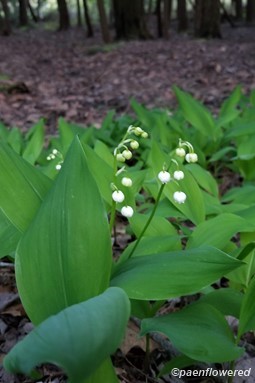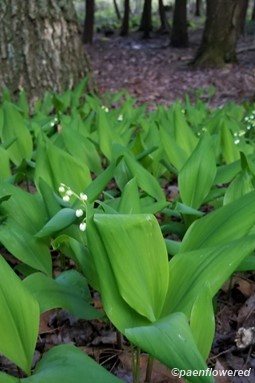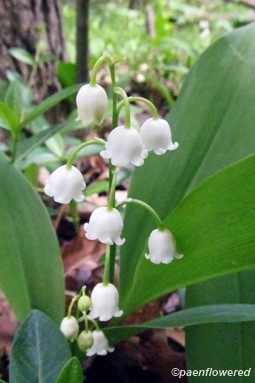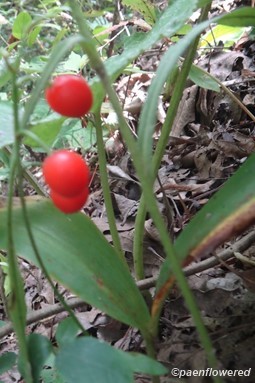Convallaria majalis
A garden escapee with white bell-like flowers blooming in late Spring
Convallaria majalis European lily-of-the-valley
This sweetly scented perennial flowering plant is native to the cool temperate part of Europe and Asia. Although it is highly poisonous to eat, it has become a popular garden ornamental in North America but has escaped cultivation in many places. There is a variety called C. majalis montana that occurs in the Appalachian region of North America and may or may not be a native species. These have flowers with a green midrib.
The lily-of-the-valley belongs to the family Asparagaceae and thus not a true lily. Unless varieties are considered as distinct species it is the only member of its genus. The flowers have six white or sometimes pink tepals (petals and sepals that look alike) that fuse to form a nodding bell-shaped flower that is about 1/3 inch in diameter. The lobes curve outward at the ends of the flowers. The flowers produce pollen but not nectar.
The flowering stem has two leaves and a cluster of 5-15 flowers. The flowering period varies with weather and latitude but is usually early to mid spring. The fruit that forms is a small reddish orange berry that contains a few seeds that dry to form a clear translucent bead. The plants spread to form colonies from the growth of underground stems called rhizomes. Plants of a single colony are usually connected and are self-sterile. This means they cannot successfully form fertile seeds using pollen from any plant in the same colony. It is said that most plants in North America do not produce berries for this reason. The prime environment for this species is in partial shade with silt or sandy soil.
In Europe the species is also called Our Lady’s Tears, based on the legend that the flowers sprang from the tears of Mary as she cried at the base of the cross of Jesus. An alternate legend has it coming from Eve’s tears as she is expelled from the Garden of Eden. It is also known by the name of may lily or may bells. Although expensive, it is popular in bridal bouquets and was used as such by both Grace Kelly and Kate Middleton.
All parts of the plant, including the berries are highly poisonous and potentially deadly, as the plant is known to contain 38 different cardiac glycosides as well as saponins and a unique poisonous amino acid. Even small amounts of the toxin can cause abdominal pain, vomiting, slowing of heart rate, drowsiness, skin rashes and dizziness. Their poisonous nature and tendency to spread aggressively are two reasons to consider avoiding them as garden plants. The flowers have been used as in the perfume industry and the plant has been a source of heart medication.
Habitat & Range
Occasionally naturalized in woods and disturbed ground.
Present throughout the state.
Wetland code: Not classified
Phenology
Flowers April to early June.
Plant Codes
S-rank: No rank
G-rank: G5 (Secure)





Comments
Have you spotted this plant in your area? We'd love to hear about your experience! Share your comments or questions about the plant below. Comments are moderated before posting.